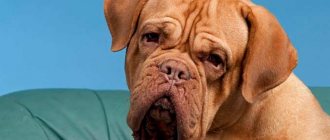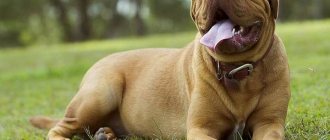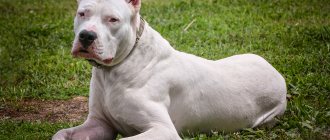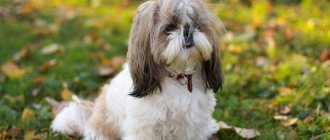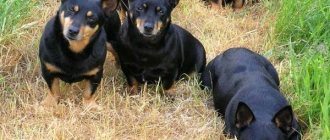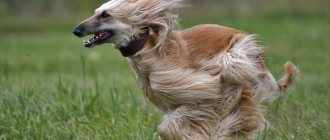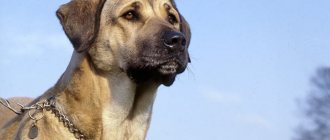- Dogue de Bordeaux
The Dogue de Bordeaux is a powerful, strong guard and a reliable friend for the whole family. In the past the dog was used in dog fighting, nowadays it is an excellent companion dog.
- Country of origin : France
- Height at withers : male: 60–68 cm; female: 58-66 cm
- Weight : male: min. 50 kg; female: min. 45 kg
- Lifespan : 10-12 years
- Use : Companion Dog, Security
- Other names : French Mastiff
Purchasing a Dogue de Bordeaux puppy is a responsible and important action that you need to think carefully about before you do it. This is especially true for those people who are going to become truly responsible dog breeders. The question of choice should be approached carefully and without haste, comparing your own habits, daily routine and the nature of the chosen breed. When the future owner has decided on the breed, a new dilemma arises: how to find a bona fide breeder? Here you need to be extremely careful not to become a prematurely disappointed dog owner.
Buying a Dogue de Bordeaux puppy is a very exciting event, because you can say that a new family member will appear. To ensure that the event does not overshadow anything, it is worth taking a responsible approach to choosing a breeder. There are no bad dog breeds; you can simply run into an unscrupulous breeder for whom money comes first. The future owner is at great risk of buying an animal that has a lot of health problems. It is for this reason that you need, first of all, to get to know the breeder well, read reviews about him and the like.
Description of the Dogue de Bordeaux breed
Popularity 239th place among 263 dog breeds
Lifespan:
9-11 years
Height:
males: 60-68 cm, females: 58-66 cm
Country of origin:
France
Average price:
5-20 thousand rubles
Weight:
males: not less than 50 kg, females: not less than 45 kg
Latest articles Cat health
Rabies vaccination for cats: choice of vaccine, necessity, schedule 01/22/2022 4 0 0
Selection and adaptation
TOP 20 best cat breeds for families with children 01/22/2022 25 0 0
General characteristics of the breed
Dogues de Bordeaux are excellent guard dogs. This is one of the ancient breeds common in France. Previously, its representatives were used for dog fighting, guarding farms and castles. This is a large dog with a powerful build and a wide muzzle covered with many folds.
The Dogue de Bordeaux is called the French Mastiff or Bordeaux. These dogs appear in films and became popular in the world after the film Turner and Hooch. In our country they have received a reputation as ferocious and aggressive animals, but this is undeserved. Although this is truly a vigilant watchman, resolutely protecting the territory from any encroachment. Boldly rushes to the defense of the owner. And since they were fighting dogs in the past, they can cause serious harm. If raised incorrectly, a dog can become uncontrollable and dangerous.
But in fact, these dogs are not aggressive and rush at a person only when there is a serious threat from him. And the rest of the time he is an affectionate and good-natured companion, a loyal friend. They have a calm, phlegmatic character, are silent and slow, and love to sleep.
| Options | Characteristic |
| breed name | Dogue de Bordeaux (French: Dogue de Bordeaux), Bordeaux Mastiff or French Mastiff |
| a country | France |
| group of breeds according to the ICF classification | Pinschers and Schnauzers, Molossians, Mountain and Swiss Cattle Dogs, Mastiff subsection |
| application | watchman, bodyguard, companion |
| life expectancy | 9-11 years |
| height | male 60-68 cm, female 58-66 cm |
| weight | male from 50 kg, female from 45 kg |
| character traits | calm, balanced, devoted, fearless |
| aggressiveness | low |
| activity | average |
| intelligence | standard |
| training | complex |
| attitude towards a person | loyal to the owner, good-natured with all family members, suspicious of strangers |
| content | in an apartment, private house |
| difficulty of care | simple |
pros
The Dogue de Bordeaux is bred as a watchman, security guard and companion. Despite its large size, it can be kept in an apartment; it is not very active and likes to sleep. With enough attention from the owners, he will not chew things and damage furniture. This dog has several more advantages:
- has innate protective qualities;
- loyal to the owner, strongly attached to all family members;
- affectionate and loving;
- balanced, calm;
- with the right approach, it is easy to train, as it quickly remembers commands;
- not noisy;
- not aggressive;
- patient with children;
- gets along with other pets;
- hardy and unpretentious, does not require serious care
Minuses
The Dogue de Bordeaux is not a breed for everyone. Beginners should not get this dog, as they may not be able to handle the training. In the absence of timely socialization and proper upbringing, she can grow up aggressive and uncontrollable. These dogs are not suitable for people who work a lot and will not be able to pay enough attention to them. And due to its large size, Bordeaux will be uncomfortable in a small apartment.
There are several other disadvantages to keeping these dogs that can cause problems:
- do not tolerate loneliness well;
- drool and snore frequently;
- get into conflicts with unfamiliar dogs;
- can be stubborn and vindictive;
- cannot stand the smell of alcohol and can attack a drunk person;
- have weak joints and low life expectancy;
- lazy and sedentary, prone to obesity.
The video complements the description of this breed:
Video: Dogue de Bordeaux. Pros and cons, price, how to choose, facts, care, history
Video: Dogue de Bordeaux (first-hand advice)
Similar breeds
Dogues de Bordeaux are similar to the Bullmastiff and Canne Corso. These are breeds from the Molosser group. Bordeaux differs from the Bullmastiff in the following characteristics:
- larger;
- a dark mask is not required on the face;
- ears are larger.
The Cane Corso, unlike the Bordeaux, has a more graceful physique; the ears and tail should be cropped, and the folds on the muzzle are less pronounced. These are active, playful dogs, slightly smaller in size.
The photographs show the differences between these dogs and representatives of other breeds:
Bullmastiff on the left, Dogue de Bordeaux (French Mastiff) on the right
Bullmastiff:
Bullmastiff
Cane Corso:
Cane Corso
Key facts
Bordos, like most dogs, chooses one owner for himself in the family, while he is an attentive friend to all other family members. Dogues are social dogs, they do not like to be alone, and therefore it seems that the Dogue de Bordeaux is with you everywhere, wherever you are. Bordos loves children dearly, but you need to carefully monitor their games with babies. Due to its impressive size, the dog can injure a child.
This dog belongs to the group of Molossians and mountain cattle dogs, so he is an excellent watchman, ready to attack any stranger on his territory. He is ready to tolerate other animals with proper upbringing. The characteristics of the Dogue de Bordeaux breed indicate their good trainability and tolerance towards “their own”.
Bordeaux requires socialization from an early age, otherwise he may grow up to be an uncontrollable dog. You will have to find the time and desire to raise him. Raising and training Bordeaux is not an easy task due to its stubbornness and willfulness. If you are obsessed with cleanliness, it is better to think about another breed.
Despite its apparent solidity, the Dogue de Bordeaux is very loving and loves affection. If you have a Bordeaux, you will never suffer from a lack of attention and will never be left without protection during an evening walk along dimly lit streets with your faithful giant.
The description of the Dogue de Bordeaux breed includes not only external qualities and character traits, but also health indicators. Thus, the life expectancy of a Dogue de Bordeaux with proper care will be 11 years. These are good indicators for large breeds. Health depends on care; the most vulnerable place of Bordeaux is the joints.
Dog kennel GERALDIKA. Basset Hound, Dogue de Bordeaux
| Description: | Dear friends! I am Elena Yuryevna Molodtsova, I have been the owner of the nursery “GERALDIKA” for more than 15 years. My favorite breeds are the Basset Hound and the Dogue de Bordeaux. The priority in my favorite business is to obtain healthy livestock with a good life expectancy and a balanced psyche. We are proud of our dogs, both purchased and born in the kennel. Our dogs' pedigrees include multiple European World Champions and international Beauty Champions. By purchasing a pet from our nursery, you will receive timely professional assistance in raising, training and show career of your pet. |
| Contacts: |
History of the origin of the Dogue de Bordeaux
The origin of the Dogue de Bordeaux is practically a detective story. Country of origin: France. The ancestor is still not known exactly. There are three theories about the origin of Great Danes:
- the ancestors of Bordeaux dogs are fighting dogs, hunters and participants in street dog fights;
- the ancestors of the breed are bulldogs;
- Genotypically, the Dogue de Bordeaux is descended from the Tibetan mastiffs.
The first version seems more plausible. The Dogue de Bordeaux is similar in appearance to the Alans, one of the ancient hunting breeds common in Spain and France. Their exterior is known because it was described in the 14th century. French hunter named Gaston de Foix. These were hunters of large prey, and they also guarded livestock and took part in battles.
Until 1863 they were known as the "French Mastiff". In 1863, at an exhibition in the Botanical Garden in Paris, the first Dogue de Bordeaux, male Magent, received a gold medal.
The breed immediately gained popularity, and breeders began actively breeding all Great Dane dogs, claiming that their offspring were purebred Bordeaux dogs. The Dogue de Bordeaux owes the preservation of the purity of the breed to the breeder Euler, who found two high-breed dogs - a male Buffalo and a female Sultana. From them, in 1892, he began to breed purebred Dogues de Bordeaux.
The Buffalo became the model for the first breed standard, which was written by veterinarian Meunien in 1896. He considered Great Danes with a dark mask on their faces to be the result of a mixture of breeds and only recognized the breeding of red Great Danes with a brown mask and undocked ears. He was also supported by dog handler Kunstler, who edited and expanded the standard in 1910.
In 1926, A. Bare defined a new standard based on the work of Kunstler, and two years earlier the first breed club was created. The same Bare became its leader. His main task was to restore the line of Dogues de Bordeaux after the First World War.
During World War II, Bordeaux were on the verge of extinction. Many killed their pets so as not to feed the extra, rather voracious, mouth. History records the name of only one breeder - Van Capel, who kept his pets throughout the war.
Most of the Dogue de Bordeaux survived in French Aquitaine. In the 1960s A. Bare resumed the activities of the breed club, and the dog handler Triquet undertook to restore it, but, despite their joint efforts, in 1966 there were only five purebred animals. By 1970, the Bordeaux population was sufficient to create a fourth standard, and a year later the Dogue de Bordeaux was included in the FCI register. In 1995, Luquet and Philippe Serouy developed an updated, current standard.
Bordeaux rose to fame after the 1989 film Turner and Hooch. They gained popularity all over the globe and gave new blood to the English mastiffs.
The first Bordeaux wines were brought to Russia in 1992. These were dogs of strong French lines, which were highly valued at international exhibitions. In 1996, at the World Championships, Russian male dogs received the first distinction in three classes at once, taking the titles of World Champion and Junior World Champion to Russia.
In France they are proud of their breed and you will find a huge amount of art and souvenirs featuring the Dogue de Bordeaux.
Appearance of the Dogue de Bordeaux
General impression
The Dogue de Bordeaux is a strong dog with an athletic build. She is quite harmoniously built, despite her rough appearance. From the photo of the Dogue de Bordeaux it is easy to determine that he belongs to the Molosser group.
Head
When viewed from above, it is noticeable that the head is trapezoidal and angular.
The girth of a male's skull at its widest point approximately corresponds to the height at the withers. The lines of the muzzle and skull converge at one point. There is a frontal groove on the forehead, from which movable skin folds radiate. The muzzle itself is wide, with a clear stop, short and powerful. The girth of the muzzle corresponds to approximately ⅔ of the girth of the head.
The eyes are oval, widely spaced. Color - from nut to dark brown. Expression is open.
The small ears of the Bordeaux are hanging, slightly darker than the main coat. They are set high and spaced far apart, making the skull appear even heavier. The ears are pressed with the front edge to the cheekbones if the dog is alert.
The nose is black or liver-colored. The upper lip hangs down, covering the side of the jaw. A characteristic of the breed is that it is undershot, that is, the lower jaw is pushed forward. The teeth are strong, the lower incisors do not touch the upper ones.
Neck
The neck is cylindrical, with a convex nape, turning into a wide withers. The head and neck are separated by a curved groove. An expressive dewlap descends from the throat to the chest, the neck smoothly widens and goes into the shoulders.
Torso
The Bordeaux has a massive bone structure, the body itself is elongated with slightly raised withers, flat, well-pressed shoulder blades and a sloping croup. The underline is neat, the chest is voluminous and wide.
Forelegs
The forelimbs are massive in the shoulder area, the elbows are tightly pressed. The shoulder-scapula joints are located at right angles. The pasterns are slightly turned outward when viewed from the front. The paws themselves are bony and muscular.
Hind limbs
The hind legs are narrower with clear angles than the front legs. The muscles of the thighs are well developed, and the angles of the sinewy joints are also pronounced. The toes are crowded, with strong claws, and there are no dewclaws.
Tail
The tail is quite long, thick at the base, without bends or seals. At rest it is lowered, the end of the tail is located in the area of the hock joints of the hind legs. When a dog runs, the tail is slightly above the horizon line, but not curled or tucked over the back.
Movement
Typically, Bordeaux dogs move at a trot; at a slow pace, ambling is possible. The movements are strong and sweeping; when running fast, it seems as if the dog does not lift its feet from the ground.
Wool
The short and soft coat has no undercoat. The structure of the wool is thin.
Color
Bordeaux colors have the right to be all shades of brown. There may be small white spots on the chest and tips of the paws.
The mask is slightly darker than the main color or black. There may not be a mask on the face. If it is not there, then the nose may be reddish or pinkish.
Dimensions
These are large dogs that weigh 45-50 kilograms; the weight of a male Dogue de Bordeaux can reach 55 kg. The height of the Dogue de Bordeaux at the withers in males is up to 68 cm, in females it is slightly less - 65-66 cm.
When planning to get a puppy, you need to correctly calculate the dimensions. The size of the Dogue de Bordeaux will require a spacious corner in the home or a comfortable booth.
Breed standard
Mastiffs were brought into Russia only in 1990. At the same time, a demonstration dog show was organized here for the first time, at which 5 such dogs were presented. Since then, no changes have been made to standardization. The Dogue de Bordeaux in the photo looks like a powerful monster. It is very large, weighing from 81 to 90 kg and tall, with a height of 62 to 68 cm. Females are smaller in weight and height than males.
The dog's physique is stocky, strong and harmonious. He has a wide rectangular back. The lower back is convex. The tail is recumbent. It is long and wide, thickened at the base. The front legs are short, the hind legs are longer.
The thigh muscles are very powerful. The dog needs them for a quick push from the ground. The belly is slightly sunken and the ribs are not visible. The chest is very powerful and wide. The neck is of medium length. But the mastiff’s head is huge.
He has thick, drooping cheeks. A large nose at the edge of the muzzle, tiny light eyes hidden under the upper folds of skin, small triangular ears. The peculiarity of the breed is the lower jaw that moves forward, but the bite of its representatives is correct. According to the standard, only 1 shade of fur is acceptable (for mastiffs it is short) - red. But there are a lot of shades. The dog may be:
- Light red.
- Kashtanova.
- Dark brown.
- Sand beige.
- Yellowish, etc.
There should be no stripes, spots or brindles on the body of a Dogue de Bordeaux dog If they are present, it will not be considered high-breed. The exception is the center of the sternum, there may be a small white spot there. Only solid color is standardized. But, on the face of such animals there must be a “mask”; usually it is darker than the main color of the body.
The animal's coat is very thick, but each of the hairs is thin. But, due to the fact that they fit tightly to each other, it seems that the mastiff has a fluffy coat. By the way, he has thick skin, so in different parts of the body, mainly the muzzle, it forms an “accordion”; in other words, folds are visible there.
Character of the Dogue de Bordeaux
Despite its serious appearance, the Dogue de Bordeaux's character is non-aggressive and harmless. These are loyal, companionable dogs that love to play and are very attached to people. The most severe punishment for Bordeaux is loneliness. They need a lot of communication, otherwise, out of boredom and lack of attention, they can damage furniture, things and misbehave in every possible way.
This breed is characterized by absolute devotion, they will follow on the heels of their owner. On the street, the dog does not stray far from its leader, even if it is walking without a leash. The walk should be active with both the puppy and the adult dog so that the Bordeaux can throw out its energy.
Who is the French Dogue suitable for? Dog handlers do not recommend taking a Dogue de Bordeaux into a family with preschool children. It is worth a closer look for a single man who has a lot of free time, or a family with older children. It’s better if the owners of Bordeaux don’t live in an apartment, but in winter it’s cold outside for a short-haired dog, so keeping it in an uninsulated enclosure is also not worth it.
Bordeaux is the terror of all area cats, but he gets along with his own home without any problems. A well-bred Bordeaux will coexist peacefully with other animals, but two males will constantly compete. The Dogue de Bordeaux has a well-developed hunting instinct, so you should not let him off the leash in the city outside designated walking areas.
A trained and socialized Bordeaux dog will not attack another person just like that, but these dogs do not tolerate familiarity from strangers.
Bordos is an excellent guard. He will simply scare an accidentally lost stranger, and if the owner’s life is at risk, the dog will fight to the death. The Dogue de Bordeaux cannot tolerate the smell of alcohol. Having smelled it, the dog becomes irritable and may attack at the slightest threat. Therefore, meetings with drunk revelers should be avoided.
Character
The French Mastiff gives the impression of a scary dog with a huge head and a powerful jaw. Just the sight of him makes your blood run cold. But it’s not for nothing that people say that appearances are deceiving.
By nature, this dog is friendly, and with every member of its pack. She quickly becomes attached to them, develops trust and becomes vulnerable in her love. Those who keep such animals in the house for a long time claim that they cannot find a sweeter and kinder pet.
Is it so? In part, the loving owners of Dogues de Bordeaux are right. However, we should never forget that this is a fighting breed with natural guarding potential. Therefore, its representatives, although friendly and pretty at home, can still behave unpredictably.
Important ! Owning a mastiff is recommended only to experienced dog breeders. This is a serious breed that needs constant monitoring and attention. Such a dog cannot be called cheerful and energetic. By temperament he is phlegmatic. He is characterized by the following features:
- Slowness.
- Inactivity.
- Good observation.
- Emotional restraint.
- Sociability.
It's hard to believe, but these wrinkly big guys are very affectionate. They love their family members so much that they are ready to devote their lives to protecting them. Mastiffs treat children especially carefully.
They are affectionate with them and behave carefully when around them. Never forget about their protective functions. Small children are protected from strangers and loud noises. They lie down next to them and fall asleep, but do not lose their vigilance.
The main trait of the domestic Great Dane is loyalty. He chooses only one leader, to whom he is endlessly loyal. Usually, it becomes a mature man. Such a dog will never serve a weak-willed person who has a number of complexes. He will choose as his patron only a strong-willed and purposeful person who leads by nature.
The mastiff is never separated from its owner even for a minute. He prefers to be nearby so that in case of trouble he can come to the rescue. Can't stand long separation. If the owner leaves the dog alone for a long time, he becomes sad and may even stop eating.
Do not forget that the Dogue de Bordeaux, despite its bodyguard skills, is still not a guard breed. Therefore, if he has to let an unfamiliar guest into the house, he will first sniff him and even try to make friends. He will not bark loudly at a stranger.
Despite his strong love and devotion to his owner, he never allows him to completely dominate him. Submits, with strong respect, but reluctantly. Prefers to maintain self-esteem, so it needs serious training.
It gets along well with other domestic animals only with early and joint socialization. Can be affable and friendly even with a cat. Such a dog has an interesting character trait - nobility. She patronizes every living creature living with her under the same roof.
This means that if someone attacks a kitten living with a Dogue de Bordeaux in the same house, it will certainly fight back and protect it. And these dogs are also very stubborn. They quickly identify their master's weakness and skillfully take advantage of it. Mastiff is such a manipulator!
Education and training
Despite their intelligence and intelligence, Bordeaux dogs are quite difficult to train. They are very stubborn and capricious, they tend to constantly test the boundaries set by the owner and try to manipulate.
How to raise a Dogue de Bordeaux? This needs to be done from childhood. The puppy must be stroked and encouraged to form positive emotions, at the same time you need to be tough so that the baby immediately understands who is the leader here. The dog's sociability borders on obsession.
You need to immediately explain to Bordeaux the rules of behavior: that you are unhappy when, for example, he chews shoes or puts his paws on people. Do not allow the leash to be tugged or tugged while you walk, otherwise going out with an older pet will become like a tug of war, and not always in your favor.
Possessing a keen mind, Bordeaux dogs learn commands on the fly. You should not take long breaks between training sessions, as Great Danes forget what they have already learned. Forcing a dog to do something, scolding, and even more so beating a dog is ineffective. The reward method works great with Bordeaux. What to reward - choose for yourself, depending on the type of dog. The food lover will be delighted with a tasty delicacy, and the gamer will be delighted with his favorite ball.
How to accustom Bordeaux to commands?
- the training should be short (40-60 minutes);
- training must be consistent;
- training should be regular;
- do not shout or hit the dog;
- do not rush if the dog thinks about the commands for a long time;
- Reward exercise with praise, treats, or play.
A trained, well-mannered dog will be your reward for your efforts. You can exercise anywhere, even in summer or winter.
Health and disease of the Dogue de Bordeaux
Possible diseases
Bordeaux are very healthy dogs, little susceptible to illness. Adult dogs have strong immunity, but contacts of puppies with the outside world should be limited until all vaccinations have been completed.
Like any large, heavy-boned dog, Bordeaux dogs are susceptible to hip dysplasia. This is mainly a genetic disease that has no cure, but the progression of dysplasia can be slowed down. It is determined by x-ray at 5-8 months. At this age, you can have surgery on the cartilage and stop the progression of the disease. Do not breed a dog with this defect under any circumstances!
Diseases associated with the gastrointestinal tract and internal organs - liver failure, pancreatitis, enterocolitis. Typically, these diseases are associated with poor nutrition, obesity, and a predisposition to allergies.
Reproductive health
Expect your bitch to go into heat when she reaches one year of age. Next, estrus will occur at intervals of 6-9 months, approximately 20 days.
It is better not to breed girls or boys before two years of age - this will negatively affect the health of the animal, and will also increase the risk of getting sick and non-viable offspring.
It is not uncommon for difficulties to arise during childbirth due to the large volume of the offspring's head. Watch the bitch at all times and keep your phone handy. If problems occur, call your veterinarian immediately.
Features of feeding and diet
What to feed your dog? It is better to consult a breeder or veterinarian about what food and how many times to feed, because nutritional standards are different at one month of age and per year. It is better to feed your dog premium dry food. Another advantage of dry food is that it does not require vitamin supplements. If you do not overfeed the dog and actively walk with it, the Dogue de Bordeaux is not prone to obesity.
How to read the composition of food and which food to choose? The ingredients whose mass fraction in the composition is greater should go first, and in descending order. That is, if corn flour and chicken by-product meal come first, then you should not buy such food. If the food is stated to be made from lamb, lamb meat should predominate in the composition and come first.
Owners often wonder whether it is possible to give store-bought treats. It is possible, but in limited quantities. You should not include sweets, fatty, smoked, or salty foods in your Bordeaux diet. Water should be available to the dog around the clock. This is especially important for dogs on dry food. Feeding occurs 2-3 times a day in adult dogs.
Care and maintenance
The Dogue de Bordeaux is a short-haired dog, so there will be no big problems with the hair. Washing a couple of times a month is enough. Although Bordeaux is still dirty, so it is possible that you will have to wash it more often.
Short hair does not get tangled. Bordeaux does not need a haircut or grooming. The main problems are related to shedding. Brushing the dog with a special furminator brush helps. But still, be prepared to clean your clothes with tape before every time you leave the house.
Dogs' ears are designed in such a way that it is very difficult to damage the eardrum, but there is still no need to reach deep into the ears of a healthy dog with cotton swabs. It is enough to periodically clean off the wax that accumulates outside the ear canal. If there is a lot of wax, there is an unpleasant odor coming from the ear, or something is gurgling inside, contact your veterinarian; most likely, this requires treatment.
The oral cavity should be examined and cleaned regularly. There's nothing wrong with plaque, but tartar can cost your pet's teeth. It is not worth removing it yourself; it is better to have the stone removed by a veterinarian.
Nails need to be trimmed once a month. An active dog that is walked a lot will most likely wear down its nails on its own.
Periodically it is necessary to treat the wool against parasites and seasonal treatment against ticks. Now there are a lot of means - tablets, collars, drops, sprays. Choose what is comfortable for you and your pet.
Before each vaccination, anthelmintic preparation is carried out. This is usually done 10-14 days before vaccination.
You need to walk with Bordeaux 2-3 times a day. It is better for the walks to be active: you can play with a ball or a stick so that your pet can throw out its energy and relax peacefully at home. Care and maintenance of Dogues de Bordeaux, of course, are considered more convenient in a house than in an apartment.
Features of maintenance and care
These dogs can be kept in a large apartment or private house. They are not suitable for street keeping, as they need constant communication with humans. You can't put this dog on a chain.
The Dogue de Bordeaux is quite lazy and slow. He would rather lie on the couch than go for a walk. You'll have to force your pet. He requires physical activity, but not very active, this dog gets tired quickly. Active games and running can make her short of breath. Therefore, the walk should be long - at least an hour, but measured.
It should also be taken into account that due to the structure of the dog’s muzzle, it does not tolerate heat well; in the summer it is recommended to walk early in the morning and late in the evening. It is advisable to take water with you on your walk. And due to the lack of undercoat, the pet will freeze in winter and will need warm clothes. In dirty weather, it is recommended to wear waterproof overalls on the Bordeaux - these dogs love to wallow in the mud.
Hygiene procedures
This is a short-haired dog, it does not require complex care. Normal hygiene procedures are required.
- Examine your ears several times a week. This will help to detect inflammation or parasites in time. If there is dirt and wax, you need to clean it with a cotton pad soaked in veterinary lotion.
- Wash your eyes daily with chamomile decoction or boiled water.
- Wipe folds on the face after each meal and after a walk. Dust and dirt can accumulate in them, which can cause inflammation or an unpleasant odor. You will also have to wipe off drool from your face several times a day.
- Brush the coat once a week with a stiff brush or silicone mitt. During shedding, which occurs once a year, this should be done more often to remove dead hairs.
- It is not necessary to bathe this dog often; once every 1-3 months is enough. If it gets dirty, you can wipe it with a damp towel. But after every walk you need to wash your paws.
- You should brush your pet's teeth weekly with veterinary toothpaste. This will help prevent the formation of tartar. Or regularly give special chewing bones from the veins.
- If the claws do not grind down on their own, they need to be trimmed. It is worth checking your paws regularly. In winter, reagents may cause ulcers and cracks to appear on roads. It is recommended to lubricate the pads with baby cream or alcohol-free antiseptic.
Nutrition
The Dogue de Bordeaux eats a lot, but it should not be overfed to prevent it from gaining weight. An adult dog is fed 2 times a day. He should eat 500-600 g at each meal. This can be dry food or natural products. To avoid volvulus, you need to feed your pet after a walk. The bowl should be on a stand at chest level.
It is easier to feed your dog with ready-made food - it is easy to dose and contains all the necessary nutrients. You just need to use super-premium or holistic brands. Bordeaux dogs can have food allergies, so food must be chosen carefully.
When feeding naturally, the bulk of the diet should be lean meat. It is alternated with offal and sea fish. It is useful to give eggs, dairy products, fresh vegetables and fruits. Meat can be mixed with cereals, but you should not give them in large quantities. It is recommended to add herbs and a little vegetable oil.
Legumes, mushrooms, river fish, and fatty meat are contraindicated for dogs. You should not give baked goods, sweets, fried or spicy foods.
Health
The Dogue de Bordeaux life expectancy is 9-11 years. With good care, a dog can live up to 13-14 years. Their health is average, although the immunity of an adult dog is strong. The weakest point is the joints. They are prone to dysplasia, dislocations, arthritis, and spinal pathologies. Bitches often have problems during childbirth.
Sometimes the following diseases also develop:
- renal or liver failure;
- food allergies;
- obesity;
- flatulence;
- volvulus;
- epilepsy;
- oncological diseases.
Tips for choosing a puppy
You need to buy Dogue de Bordeaux puppies from a reputable breeder. Puppies must have a puppy card, and their parents must have an RKF-FCI pedigree. Ask the breeder for photos or scans of all documents, championship certificates, test results for dysplasia of both parents - dogs with this disease should not be allowed for breeding!
A decent breeder is happy to talk about his dogs and give any advice. Don't ask first what the price of the puppies is; the breeder may get the impression that you are not interested in anything other than the price.
How to choose the gender of a puppy? Bordeaux females are more cunning and persistent than males, but they have a less dominant character, they are obedient, and easier to train.
A good breeder's puppies are well-fed, curious, friendly, and kept clean. But sometimes the adorable babies themselves interfere in the buyer’s choice - future owners go for a specific puppy, but leave with a completely different one. A purebred puppy, in addition to a puppy card, will have a brand and a veterinary passport. The breeder usually comes up with a nickname for the pedigree, since it must begin with a certain letter and be combined with the name of the nursery. At home, you can come up with your own name for the dog.
How to choose a puppy
When planning to get a charming four-legged friend, decide on its class. Dogs in the “show” category can win the show because they best meet the breed standard. For animals of the breed class, minor deviations are allowed, but this does not prevent the dogs from being used for breeding. Dogues de Bordeaux of the pet class are typical pets, whose non-compliance with the standard does not allow participation in exhibitions or breeding programs.
The next stage is the sex of the animal. Bitches are more obedient, but they are not lacking in cunning and feminine cunning. Males are quarrelsome and independent, so you will have to show remarkable strength of character in dealing with them.
Now you can start looking for a trusted nursery. Before meeting the babies, ask the breeder to introduce you to their parents. Pay attention to possible defects: they can be inherited by puppies. It is equally important to check the necessary documentation: veterinary passport, pedigree diploma, test results for dysplasia. Only after this can you go to meet your future friend.
A healthy puppy is moderately playful and curious. The animal should not limp, whine for no reason, hide cowardly, show lethargy or excessive excitement. Carefully examine the baby and finally check the brand and nickname with his passport. Now you can start concluding a deal with the breeder.
